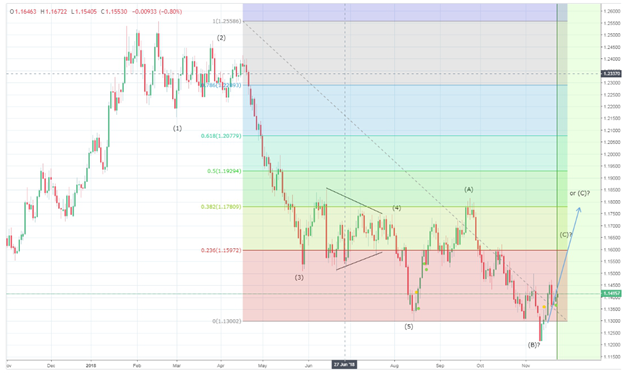



The dollar has lost ground for two consecutive trading sessions and is drifting lower from a 16-month high of 97.69 hit earlier this month.
· The euro and sterling edged higher against the dollar on Friday after Britain and the European Union agreed a draft text setting out their future relationship before a summit on Sunday.
Traders were cautiously optimistic about the draft declaration agreed by the United Kingdom and the European Commission which outlined how the trading relationship, security and other matters will work once the divorce is finalized.
The euro and sterling traded marginally higher on Friday, having advanced overnight by 0.2 percent and 0.8 percent respectively.
Traders are still waiting for more clarity around the Brexit deal as it faces a rocky ride once it reaches a deeply divided British parliament, with hardline euroskeptic and staunch pro-EU factions, and various shades of gray in-between.

We have preferred not to change the time frame or potential wave counts for EURUSD 0.14% , that we had discussed yesterday. The single currency is seen to be trading above 1.1400 levels again at point in writing, looking poised to continue its rally above 1.1500 levels in the short term and towards 1.1800/20 levels in the medium term. After having produced an impulse drop from 1.2500 through 1.1300 levels respectively, the EURUSD 0.14% could be producing a 3 wave corrective rally (A)-(B)-(C), unfolding as a potential expanded flat until now. If the above count holds to be true, we could witness an extended rally towards 1.1800 or higher levels as Wave (C) unfolds into 5 waves. A safe trading strategy therefore could be to remain long or initiate fresh longs around 1.1350 levels against 1.1213; with potential targets above 1.1800 levels.
· The trade war between the Washington and Beijing is pushing many global companies to rethink the manufacturing and fabrication work they now do in China — and a bloc of Southeast Asian countries stands to benefit tremendously, according to a senior partner at consulting firm Bain & Co.
In the short term, there will be an adverse effect on the region as an exporting base for the world, and for the U.S. in particular, Satish Shankar, managing partner for Southeast Asia, told CNBC's "Squawk Box" on Friday.
"Certain intermediate exports that go into China, and then onto the U.S., are going to be impacted in industries such as textiles and electronics," he said. "However, in the long term, we feel pretty confident that ASEAN is a very attractive alternative supply chain base for companies looking to diversify away from China."
· Investors are now closely monitoring a much-anticipated meeting between the two countries when Xi meets President Donald Trump at the upcoming G-20 summit on Nov. 30 and Dec. 1 — as they look for clues on whether there may be a breakthrough in the impasse.
Even if trade tensions eventually simmer, companies would still try and shift some of their supply chains to Southeast Asia, Shankar said.
· Trade tensions between the U.S. and China could go into "a temporary hiatus" in the coming months, but would remain unresolved until the presidential elections in 2020, according to Standard Chartered Private Bank.
That's because Washington's decision to resolve tensions with Beijing will likely be driven by politics, said Steve Brice, chief investment strategist at Standard Chartered Private Bank. U.S. President Donald Trump will be seeking a second term in the White House during the 2020 presidential elections.
· Trade talks between the United States and China should be equal and mutually beneficial, Chinese Vice Commerce Minister Wang Shouwen said on Friday, adding that he hoped the two countries can find ways to manage their differences through dialogue.
U.S. President Donald Trump and his Chinese counterpart Xi Jinping are expected to hold talks during the G20 summit in Buenos Aires next week as trade ties between the world's two largest economies become increasingly fraught.
· The Fed is expected to deliver its fourth rate hike of 2018 in December, but markets are trying to gauge how much tighter can policy get next year without risking a slowdown in the domestic economy, which has so far held up well even as borrowing costs have risen.
"The Fed is most likely to hike rates in December. I don't see a shift in forward guidance at next month's meeting as that would imply that a significant deterioration in economic activity is already taking place," said De Garis.
· Oil prices slumped to 2018 lows on Friday in choppy trading, pulled down an emerging crude supply overhang amid a bleak economic outlook.
International benchmark Brent crude oil futures hit their lowest since December 2017 at $61.52 per barrel, before recovering to $61.88by 0622 GMT. That was still 72 cents, or 1.2 percent below their last close
U.S. West Texas Intermediate (WTI) crude futures slumped by 2.5 percent, to $53.29 a barrel, after coming within 5 cents of an October 2017 low reached earlier in the week.
Amid the plunge, Brent and WTI price volatility has surged in November to approach levels not seen since the the market slump of2014-2016 and, before that, the financial crisis of 2008-2009.
Saudi Arabia is pushing OPEC to cut oil supply by as much as 1.4 million bpd to prevent a supply glut.
The group officially meets on Dec. 6 to discuss its supply policy.
Reference: Reuters, CNBC
